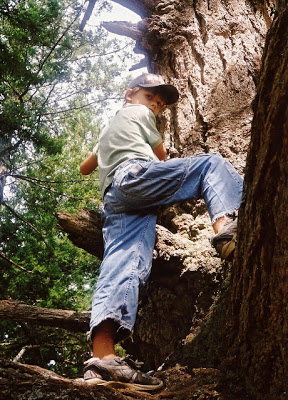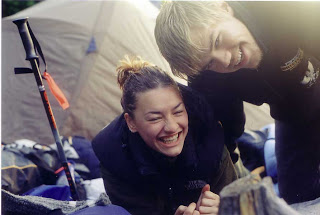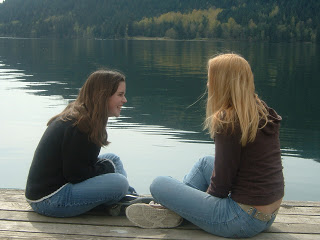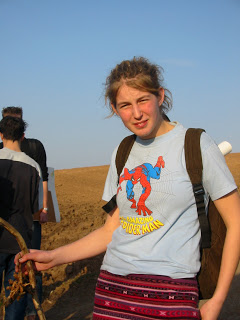 One of my son’s favorite activities as a child was to climb trees. Any tree would do: spindly little Charlie Brown Christmas-type trees, grand dame oaks, distinguished firs, sticky pines, scratchy cedars, or the budding cherry blossom—his all-time favorite. At around age three, he began his tree-climbing pursuit in earnest. He started developing his physical courage muscles on the trees in our yard. It didn’t take long for him to master the first few limbs on his favorite tree and, like Jack and his beanstalk, want to spend everyday climbing higher and higher and higher. It was those first few attempts at getting higher that our coaching as his parents became really important!
One of my son’s favorite activities as a child was to climb trees. Any tree would do: spindly little Charlie Brown Christmas-type trees, grand dame oaks, distinguished firs, sticky pines, scratchy cedars, or the budding cherry blossom—his all-time favorite. At around age three, he began his tree-climbing pursuit in earnest. He started developing his physical courage muscles on the trees in our yard. It didn’t take long for him to master the first few limbs on his favorite tree and, like Jack and his beanstalk, want to spend everyday climbing higher and higher and higher. It was those first few attempts at getting higher that our coaching as his parents became really important!
My son, E., age 8
He’d hang from his arms on the lowest limb, gaining an appreciation for gravity and the feel of his feet off the ground. He wasn’t fearless to begin with. And neither were my husband and I. Heights are one of my husband’s few dislikes; though he has gained mastery over this particular fear by continuing to place himself in situations that test it. We are both mindful not to pass along our fears to our kids—as much as possible! We also wanted to coach our kids to gain what social psychologists term an ‘internal locus of control’. The natural evolution for a child is to move from more of an external locus of control (relying on his/her parents, fate, luck, or other external circumstances to guide decision-making and behavior) to an
internal locus of control (whereby a child is more self-motivated, self-disciplined, and believes his/her behavior is guided by personal decisions and/or efforts).
Securely attached kids, it turns out, also show a higher degree of internal locus of control.
First of all, we never lifted our son into a tree to get him started. He had to reach new heights all on his own steam. He
Once he was physically capable enough to reach for his next tree branch, as it would seem nature had intended, he also had the language capacity to ask “Mommy, do you think I’m okay up this high?” “I don’t know sweetie ‘cause I’m not in your body, what do you think? How do you feel right now?” would invariably be my typical responses. I wanted to reflect back his question in ways that would force him to listen to himself instead of turning his gaze to me as his safety gauge, thus drawing his attention from the task at hand and really putting him at risk!
Of course, I was spotting my son carefully, while working on not projecting my own anxiety or judgments. Of course I was nervous for him in moments—as was my husband. Instead, I channeled my anxiety into coaching and reassuring him that I was his spotter. I climbed trees right along with him to refresh my memory of what is required physically, mentally, emotionally to climb a tree well. I reminded him that at any time, he could slowly, carefully climb back down. I coached him to pay attention to whether or not he had a handle on the limb a.k.a. the situation! If he didn’t feel okay, I coached him to ask for help. My husband channeled his worry into building a few tree forts together, at reasonable heights, to distract our son from always wanting to peak out at us from the tippy tree tops.
I found my son in his favorite tree one day when he was seven and his feet almost touched the ground from the height of the tree’s lowest limb. He was in tears. I asked him what he was sad about. His response, “Mommy, I never want to grow up. EVER!” I was flummoxed for about a moment. I was impacted by his grief about getting older. Fortunately, I was wise enough not to start off with a lecture about merits of adulthood, but zipped it and asked a simple question instead: “Why?” I asked. “’Cause grownups don’t climb trees.” “Are you kidding me? Of course they do! Firefighters climb trees to rescue kitties. Tree surgeons heal sick trees. Loggers climb to cut down or trim trees. Telephone service people climb trees to install phone wiring. And so on, and so on.” His response: “Oh! I guess I can grow up then!”
The long and short of it is that we made the inspired decision to move to an island covered in trees to truly support our son’s love of tree-climbing, escape other parents’ fearful glares when he climbed at the local playground, show our son that adults can still climb trees and have fun whilst following their own bliss, and raise our kids free-range style for awhile.
The truth about the internal vs. external locus of control personality continuum is that sometimes we need to rely on an external locus of control to help us out of sticky situations: a prayer to God to relieve a worried mind, excusing a poor test result due to having missed the review class, asking a friend or parent what advice they may have, or otherwise forgiving ourselves and cutting ourselves some slack. But, we won’t always be there to be our child’s reliable spotter, or even cheerleader, so my goal is that my kids develop an internal locus of control to know that they are, in fact, the masters of their own destiny. When my now-adolescent son peeks out of tree tops on a daring ropes course, his fearless smile wide with pride, he knows he did it all by himself…and that he’s solely responsible for getting himself safely back down to the ground! I still breathe a sigh of relief when his feet finally touch the ground, offer up thanks for his safe return, and beam with pride myself as he now laps me on this wacky ropes course called LIFE.
A Footnote:
On the eve of our departure from our island home, on our way by RV to Upstate New York, a film crew making a movie about people of all ages who continue to love the lost art of climbing trees came knocking at our door. “You’ve come to the right place! He’s in the backyard climbing,” I said, pointing them in the direction of our son’s favorite tree.
Go out and climb a tree TODAY!
What’s your favorite tree-climbing story? Post it in our comment box…we’d love to hear from you!
My son inspired his sister to take up tree-climbing, too. B., age 5
 As I have mentioned a few times before, I spent a bit over a year of my childhood in Switzerland, a small country conveniently located within driving distance of most of Europe. This put countless museums, castles, and cathedrals within my family’s reach, and we logged a lot of miles in the red VW bug and collected a lot of stamps in our passports.
As I have mentioned a few times before, I spent a bit over a year of my childhood in Switzerland, a small country conveniently located within driving distance of most of Europe. This put countless museums, castles, and cathedrals within my family’s reach, and we logged a lot of miles in the red VW bug and collected a lot of stamps in our passports. One of my son’s favorite activities as a child was to climb trees. Any tree would do: spindly little Charlie Brown Christmas-type trees, grand dame oaks, distinguished firs, sticky pines, scratchy cedars, or the budding cherry blossom—his all-time favorite. At around age three, he began his tree-climbing pursuit in earnest. He started developing his physical courage muscles on the trees in our yard. It didn’t take long for him to master the first few limbs on his favorite tree and, like Jack and his beanstalk, want to spend everyday climbing higher and higher and higher. It was those first few attempts at getting higher that our coaching as his parents became really important!
One of my son’s favorite activities as a child was to climb trees. Any tree would do: spindly little Charlie Brown Christmas-type trees, grand dame oaks, distinguished firs, sticky pines, scratchy cedars, or the budding cherry blossom—his all-time favorite. At around age three, he began his tree-climbing pursuit in earnest. He started developing his physical courage muscles on the trees in our yard. It didn’t take long for him to master the first few limbs on his favorite tree and, like Jack and his beanstalk, want to spend everyday climbing higher and higher and higher. It was those first few attempts at getting higher that our coaching as his parents became really important!
 Make sure to look your fellow human beings in the eyes, smile, and observe how the world smiles back at you.
Make sure to look your fellow human beings in the eyes, smile, and observe how the world smiles back at you.






